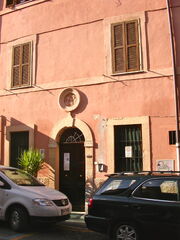Santa Maria Assunta al Gianicolo is a small and obscure earlier 19th century confraternity church at Via delle Mantellate 11/A on the lower slopes of the Gianicolo, off the Via della Lungara in northern Trastevere.
The dedication is to the Blessed Virgin Mary, under the aspect of her Assumption.
JUNE 2018 -CHURCH SEEMS TO BE CLOSED DOWN.
History[]
The church began in 1820 as an oratory for a confraternity of pious young people called the Mucciolini, named after its founder Don Antonio Muccioli. This priest had succeeded Don Gioacchino Michelini as director of the secular institute of Santa Francesca Romana a Ponte Rotto, itself attached to the (now lost) parish church of San Salvatore a Ponte Rotto.
Don Antonio bought part of the garden of the Villa Alibert, which is a 17th century casino at the end of the Via degli Orti d'Alibert (the next street north of the Via delle Mantellate), and built a chapel in an adjacent house which became a spirituality centre. The garden attached to this was a place where the youngsters could recreate without danger of molestation. They were inhabitants of the Trastevere slums, and had no access to any sort of green space otherwise. In 1824 he formally transferred the property to the institute at Santa Francesca.
At the end of the 19th century, the Pii Operai at the nearby church of San Giuseppe alla Lungara took administration of the church. The charitable outreaches for girls were supervised by the Suore Agostiniane del Divino Amore at the Conservatorio Pio on the Via Garibaldi nearby -see Cappella delle Suore Agostiniane del Divino Amore.
Unfortunately, the little complex was allowed to fall into disrepair in the later 20th century. The slums were cleared up, the poverty-stricken inhabitants moved out to the peripheral suburbs and the locality gentrified. Hence, the social outreach here became misplaced (indigent immigrants did not favour Trastevere).
In 1980, restoration began as a catechetical centre -the Oratorio Paolo VI. This was completed in 1984, and given into the responsibility of the Carmelites at Santa Maria in Traspontina.
Meanwhile, the Suore Agostiniane at the Conservatorio Pio closed down in 1996.
Present status[]
At present (June 2019) the Diocese lists this place of worship as a full church, a dependency of the parish church of Santa Maria in Traspontina. However, it is an enclave in the territory of the parish of Santa Dorotea.
The website of the latter used to advertise a Mass here on Sunday at 11:30, but this seems to have ceased in 2017. The Opera Beato Paolo VI (as it has become) seems no longer to have a presence here, and so the church seems to be closed down again.
However, its continued listing on the diocesan website indicates that it has not been deconsecrated.
Location[]
The address is at the far end of Via delle Mantellate, just before the steps and on the right.
On the way there is an arched doorway, with a tondo containing a relief of the Holy Family above. This is at number 22.

This tondo at number 22 contains a relief depicting the Holy Family.
Exterior[]
The address is actually a garden gate, a brick archway topped by a horizontal projecting cornice. On the keystone of the arch is a plaque with the inscription: Utile dominio dell'Opera Pia di Ponte Rotto. This is a reminder of the origins of the church.
There is an irregularly built and nondescript three-storey house at the far end of the garden wall, and the church is built on top of this. The brick fabric is rendered in yellow ochre (now shabby). Very oddly, a doorway with a triangular pediment hangs over the street, opening into the second storey of the house. Why?
The actual church amounts to a fourth storey, with its major axis parallel to the street and narrower than the rest of the house below. It has its own pitched and tiled roof. Further down the street, you can see the eastern frontage with an enormous lunette window set well down -the rest of the frontage is blank.
Interior[]
Details of the interior are from the Swedish Wikipedia page (see link below), the only other source online concerning this church apart from this Wiki page.
According to this, the interior is in wood and in a Classical style. There is a gilded set of Stations of the Cross, and a pilastered high altar carved with Marian emblems as well as roses and lilies. The original 19th century altarpiece showing The Assumption of Our Lady was stolen during the Eighties restoration and replaced with one showing Our Lady and the Child.